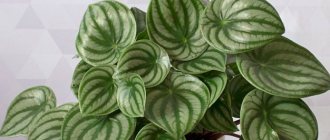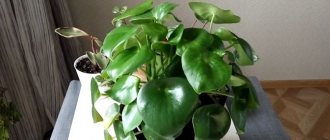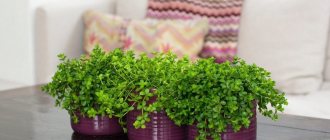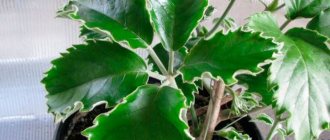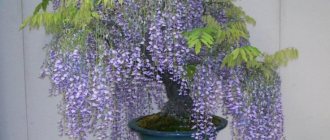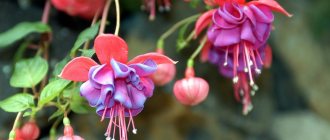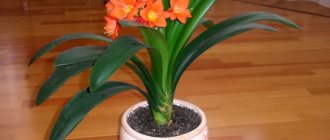What does a flower look like
The plant belongs to the Pepper family. Its veins seem to be recessed, and the leaf itself seems slightly swollen. The color comes in different shades of green with a mottled and waxy coating. The plant is native to South America.
Spectacular flower appearance
For your information! The Lilian species can grow up to 32 cm in height. It is used to create ampel compositions. Small pots are hung or placed on the windowsill.
The prevalence of the flower is due to the fact that it is resistant to dry soil or excessive watering. The perennial does not need frequent feeding.
Description of the plant
Peperomia lilian (or wrinkled) is a compact herbaceous shrub. A mature bush does not grow higher than 32 cm. The shoots are quite strong. The leaves are fleshy, glossy, round (to be more precise, heart-shaped), rich green on the upper side and lighter on the back.
The inflorescences are oblong, cob-shaped, rising above the foliage. Snow-white flowers are placed on pinkish stalks. This perennial got its name precisely because of the peculiar shape of the inflorescence, similar to lily flowers.
Peperomia can grow as a bush. In a small pot you can create a compact but picturesque composition. To decorate a room, flower growers prefer to grow shrub and hanging species. They can also decorate a balcony or window opening. Lilian is known among flower growers for its decorative qualities.
Peperomia Caperata (Lilian), like other varieties of this plant, belongs to the Pepper family. If you rub its leaves, a characteristic smell will appear. The name of the plant comes from the ancient Greek language. Translated, peperomia means “pepper-like.”
Peperomia prefers to grow in shady places. In natural conditions, it can often be found under trees and on loose soils. It can grow even on rocky surfaces.
Other popular varieties
In addition to Peperomia Lilian, domestic gardeners grow other varieties of the plant. About 30 species that grow in the wild can thrive even in a small pot of soil.
The most popular species in our country include peperomia wrinkled, blunt-leaved, magnolia-leaved, Rosso, etc. They differ in shape, leaf size, and inflorescences.
Peperomia blunt-leaved can reach a height of 40 cm. Its rounded leaves are covered with a waxy coating. The leaf cuttings are thick.
The creeping plant is Peperomia capita. Its shoots reach 22 cm in length. Can be grown in an ampel form or as a ground cover flower.
Peperomia look quite impressive: magnolia-leaved and round-leaved. In the first variant, the leaves have an oval shape. They have stripes on the surface. The color of the veins is dark. In some cases, there are light yellowish spots on the leaves. The round-leaved variety looks impressive. Its leaves are very small (up to 1 cm). They cover the shoots, forming a dense bush.
Chisel-shaped peperomia is distinguished by its original shape of foliage (similar to a crescent). It blooms with small green buds. The foliage resembles pea pods.
A relatively tall plant is the clusielifolia peperomia. It can grow up to 50 cm in height. The leaves are also quite large and succulent. Their size can reach 15 cm. The leaf blades are purple in color.
A striking plant is the Rosso variety. On the fleshy leaves the blades are very bright. They can even be confused with inflorescences.
Benefits and harms
Peperomia has a positive effect on the functioning of the digestive system, as well as on the atmosphere in the room.
It is believed that the flower has a beneficial effect on the atmosphere in the room, reduces negative manifestations, and puts the inhabitants of the apartment in a positive mood.
It is recommended to place pereromiya in the room of a frequently ill child; the phytoncides released by the plant cleanse the air of harmful bacteria.
Features of caring for Peperomia Lilian
Caring for a plant is not difficult, but you need to familiarize yourself with the basic growing criteria, find out at what temperature to keep the crop, and how to irrigate it.
Temperature
Peperomia watermelon - home care
Due to the tropical origin of the flower, it loves warmth and does not tolerate drafts. In spring and summer, the optimal temperature is 20-22 °C. In winter, the indicator should not fall below 16 °C.
Lighting
The main condition is that the perennial should not be exposed to direct sunlight, so it is best to grow flowers on the windowsills of the eastern and western rooms.
Important! If the side is south, then you will need to create a shadow or place the pot deeper into the room.
In winter, it is necessary to create artificial lighting. This is achieved through the use of electric lamps. They extend daylight hours.
Also, in the cold season, the perennial needs protection from drafts, but in the summer it can be taken out into the air. With darkening, the crop is brought into the room, since low temperatures and cool winds will harm the plant.
Watering
Watering depends on the time of year. During the growing season, increased irrigation must be provided. It is better to choose soft, settled water without precipitation at room temperature. In winter and autumn, watering is reduced. During this period, the flower tolerates a lack of moisture better than excess irrigation.
Excessive watering leads to the development of fungal diseases. But watering from time to time is simply necessary so that the leaves do not fall off from lack of water.
Important! In summer you can spray the leaves with a spray bottle. This will help wash away dust and give the flower freshness.
Humidity
Home culture does not require creating high humidity in the room. It grows well with or without spraying. The plant develops equally well in dry and humid areas.
Priming
When choosing soil for growing Peperomia Lilian, you need to consider the following criteria:
- the substrate must allow air to pass through well and not clump;
- the soil should not retain excess moisture.
Universal earth
To grow a perennial at home, a gardener can choose one of the following mixtures:
- 2 parts leaf soil and 1 part each sand, humus and peat;
- a mixture of leaf, peat soil and sand, the mass is taken in the same quantity.
Important! Soil acidity should be between 5.5 and 6.5 pH.
Feeding
In order for the flower's leaves to remain bright throughout the year, it needs nitrogen-based fertilizers. Ready-made fertilizers for ornamental plants are suitable, containing not only this element in the required quantity, but also other useful substances: manganese, potassium, phosphorus and boron. Peperomia loves organic matter.
In spring and summer, it is recommended to alternate feeding with mineral and organic compounds. They are applied once every two weeks. In winter and autumn, fertilizers are needed, but in limited quantities. The concentration is reduced and the intervals between application and irrigation are increased.
Bio fertilizer with high nitrogen content
Home care
Caring for potted peperomia will not require complicated procedures from you. It is enough to take care of the correct regime of watering, fertilizing, as well as periodically forming and replanting the bush.
Watering
In summer, watering should be moderate, and in winter extremely rare (the next moistening of the soil is carried out only at the moment when it dries well). Use settled, soft water, the temperature of which is several degrees higher than in the room. Pour water from above from a vessel with a long spout, being careful not to splash the leaves.
Top dressing
During the phase of active vegetative growth, fertilize peperomia shriveled once every two weeks. During the winter months, reduce the procedure to once a month. Fertilizer for this crop can be universal liquid fertilizer (marked for indoor plants).
Trimming
Pruning gives the bush an opportunity to refresh itself and acquire a more aesthetic appearance. In the future, the procedure will add density to the crown. Since adult specimens are difficult to tolerate pruning, it is advisable to form the crown before the age of 2–3 years. Before shaping, carefully inspect the bush, then use sharp scissors to cut off weak branches. Flower growers recommend sometimes getting rid of inflorescences when pruning. The purpose of the operation is to preserve the strength of Peperomia.
Transfer
Peperomia lillians are transplanted in early spring using the transshipment method. A young plant (up to 3 years old) is moved to a new flowerpot annually, then once every 2 years or even less often, as needed. Peperomia loves loose neutral or slightly acidic soil.
The most optimal mixture is sand, peat and leaf soil in equal quantities. It is advisable to pre-calcine or steam the soil to destroy fungal infections and parasites. Each time when replanting, take a pot with a diameter 2 cm larger than the previous one, and a little deeper.
Important! After replanting, do not feed the shrub throughout the growing season until next spring.
Place the flower in a new pot according to the following scheme:
- Place a 6-centimeter layer of drainage (expanded clay, broken brick, eggshell) on the bottom of the pot.
- Carefully remove the bush from the old flowerpot along with a lump of earth.
- Shake the entire substrate from the rhizome, then carefully rinse the roots, being careful not to harm them.
- Pour water evenly into a new pot with fresh soil mixture, thus moistening the soil.
- Place the bush in the center, straightening the roots and sprinkling them with soil. There is no need to compact the earth. Instead, moisturize it. Wait until it settles, add a new portion of soil. Drain the water from the pan.
Reproduction
Peperomia corrugata can be propagated by leaves, stem and leaf cuttings, as well as seeds.
Leaf
Prepare a mixture of sand and peat in equal proportions. Place a healthy leaf in it without damage. Cover the top with glass. With this method, rooting occurs noticeably faster than with propagation by chibouks. After just 12 days, the first roots will form, and by day 25, full rooting will occur.
Cuttings
To propagate peperomia from stem cuttings, pinch off its crown in spring or summer. To root the petioles, it is better to use a special greenhouse container. Plant the petiole in a soil mixture of peat, sand and leaf humus. The whole process will take at least three weeks. Transplant the rooted chubuk into a small flowerpot.
Propagation by leaf petioles is a fairly simple method that is worth paying attention to. Your task is to plant a leaf with a short stalk (with 1–3 nodes) in wet sand. Otherwise, repeat the same steps as when propagating by stem chibouks. Also, try to keep the humidity in the room high.
Seeds
Propagation by seeds is a rather labor-intensive method suitable for experienced gardeners. Under indoor conditions, the crop practically does not produce seeds; you will have to buy them. Scatter the purchased seeding material over the surface of loose soil, then cover the container with seedlings with glass.
Important! Water the seedlings only through a tea strainer, as a large stream of water can stop the growth of peperomia.
While waiting for seedlings, it is important to maintain the temperature within +23...+24 °C and air humidity not lower than 35%. When the young bushes reach the stage of 2 true leaves, you can start picking. After strengthening, you can plant the seedlings in separate flowerpots.
When and how does it bloom
Peperomia - flower care at home
Next, it’s worth finding out how the crop blooms and at what time this happens.
- Types of flowers. Peperomia flowers are visually similar to lilies, hence the name. But on each long red-brown peduncle many small inflorescences appear, gathering in a bunch.
- Flower shapes. The inflorescences have an oblong shape, resembling a cob. Small flowers look like flags, which are placed on one peduncle.
- Flowering period. The crop blooms in late spring and early summer. The buds do not emit aromas; their value is less significant than the leaves. Flowering occurs throughout the summer.
- Changes in care during the flowering period. Care during the flowering period is slightly different, namely the need for abundant watering of the crop. The flowering process takes a lot of energy, and as a result the bush becomes less dense.
Note! Sometimes the stems need to be cut to help the plant branch better. The affected leaves are also removed. Timely cleaning increases the perennial's resistance to diseases.
Lighting and temperature
You should follow certain recommendations from experienced gardeners when growing a plant such as Peperomia Lilian. Home care does not require complex procedures. It is enough to provide the correct lighting, temperature conditions, water and feed the plant on time. It will also need to be replanted periodically.
When studying the features of growing peperomia at home, you should start with such important conditions as lighting and temperature. Like any plant, the Lilian variety has its own preferences. Peperomia loves sunlight. However, it does not tolerate direct exposure to rays on the leaves. They fade, become lethargic and tired. If the window in the room faces south, it is better to place a flower pot in the back of the room. As a last resort, you can leave it on the window, but you should create protection from the sun. To do this, place a small canopy over the leaves.
The dark leaves of Peperomia Lillian prefer shade or partial shade. In such conditions the plant will be comfortable.
Peperomia does not like sudden changes in temperature. Therefore, it is recommended to maintain it at the same level. In summer and spring, temperatures can range from 20 to 25ºС. In winter, this level can drop to 17ºC. If the thermometer drops even lower, there is a danger of various diseases appearing in the flower.
Peperomia should not be taken outside or onto an open balcony. If it is necessary to transport it, the pot is covered with thick cloth and tied in a plastic bag. Peperomia does not tolerate drafts. If this moment is missed, the leaves may wither and fall off.
How does it reproduce
There are several ways to propagate flowers, each worth considering in detail.
Germination of seeds
Peperomia magnoliafolia - home care
The best time for sowing is March and April. Prepare a mixture of sand and leaf soil. The pot is chosen in the shape of a bowl. After immersing the seeds in the soil, the container is covered with glass. Irrigation is carried out using a fine sieve. The water should be warm, about 25 °C. You also need to ventilate the planting material by opening the glass.
Transplantation occurs when the second leaf appears. Prepare a wooden box with the same soil. Bushes are planted at a distance of 2-5 cm from each other. Tara is sent to a bright room where direct sunlight does not penetrate. After three weeks, they dive into a separate pot with a diameter of up to 7 cm.
Rooting cuttings
To grow a plant using stem cuttings, prepare a mixture of sand, peat and humus. You can use the apical branches. It is important that there are up to three nodes on the cut stem.
Before immersion in the soil, the formation of the root system is stimulated. To do this, the shoot is immersed in water. Having planted it in a pot, it is covered with a bag. If everything is done correctly, the first roots will appear within a month.
For your information! An interesting method of propagation by sheets. To do this, take a large green leaf without defects and cut it with a blade. The cutting is left short. Plant in the ground and cover with a bag.
Reproduction
There are three main ways to propagate a plant: seeds, cuttings, and from leaves.
Growing from seeds at home
The method of propagation by seeds is considered the most difficult, since Peperomia lilian does not produce seeds; they have to be bought in the store.
- The seed must be spread out in soft soil and covered with glass on top, the seedlings need a greenhouse climate - the temperature should be within 24 degrees, the plant also needs an optimal level of humidity.
- It is recommended to water peperomia through a fine sieve; a strong stream of water can lead to a halt in development.
- Diving is carried out after the germination of 2 leaves, the distance between the seedlings is two centimeters, after which the boxes are placed on window sills, it is recommended to place the container in a shaded place.
Seating in separate dishes is carried out after they are strengthened.
Cuttings
The stem or top of the plant with 1-3 nodes must be placed in moist soil of soil, sand and peat, and placed in a warm place until rooting. The formation of the root system can take 3-4 weeks, after which the periomyia must be planted in separate containers.
Leaf propagation
Strong leaves with short cuttings must be placed in a peat-sand substrate for rooting; to create a greenhouse, the flower must be covered with glass on top. The formation of roots requires less time than when propagating by cuttings; the first signs of the root system appear already on the 12th day, full rooting occurs on the 25th day.
Transfer
Small-leaved plants are replanted annually. It is best to do this in the spring. You can also replant a perennial if an urgent need arises, when roots stick out from the holes in the pot.
The root system of peperomia is not branched, so replanting does not require a spacious, wide pot. The roots grow slowly, so it is recommended to purchase a small and shallow container.
Step by step procedure:
- Take a pot that is 2 cm larger in diameter than the old one. The maximum diameter of the container for a perennial is 9 cm.
- A 1/3 layer of drainage is placed on the bottom of the pot. It can be made from pebbles, broken bricks, foam plastic, expanded clay. Then pour 1.5-2 cm of soil.
- Peperomia is removed from the old container and, without destroying the lump, transplanted into a new container.
- Empty spaces are covered with soil and compacted a little.
- Then the plant is slightly irrigated and placed on a warm windowsill in partial shade.
Pest Control
Peperomia is resistant to various diseases. The main problems arise due to improper care of the plant. Weakened leaves and shoots of the plant are susceptible to insect damage -
pests.
If improper care procedures are carried out, the appearance of mealyworms, nematodes, mites or scale insects is inevitable. If symptoms of the presence of harmful insects have been identified, it is necessary to urgently take measures aimed at their destruction. It is necessary to treat with fungicides.
In addition, it is recommended to transplant the plant into steamed soil. The flower requires special attention and care. Be sure to follow the recommendations related to caring for this amazing flower.
Thanks to this, the plant will be able to restore its strength and will again delight with its splendor and beauty.
Possible problems in growing
The plant is susceptible to insects and infections.
When the air is very dry, spider mites infest. A web appears on the stems between the nodes, the leaves wither and fall off. To rid a perennial of a pest, you need to wipe the flower with a soapy sponge. Also spray with a mixture of water and 0.15% Actellik solution in a proportion of 1 ml per 1 liter of water.
Spider mite
Sometimes thrips appear due to high temperatures and low humidity. Colonies are concentrated on the leaves below. Light dots form at the top. The plant must be sprayed with insecticides.
For your information! Sometimes the flower is affected by diseases. Its roots and root collar may rot. This occurs due to fungal infections that form due to soil compaction or excessive watering. In this case, the plant is transplanted into new soil and the amount of watering is reduced.
Plant pests and diseases
Peperomia lilian is susceptible to attacks by spider mites, thrips, mealybugs and nematodes. To combat the listed harmful insects, use insecticides such as Decis, Fitoverm or Actellik. Wipe the affected areas with a rag soaked in insecticide or spray the crown with the same composition.
To avoid the parasites moving to other flowers, the affected bush must be moved away from healthy ones. And treat the place where it stood with a disinfectant. Regular spraying of the flower with water can help prevent infection by parasites. The crop may be affected by a virus that causes dwarfism. To prevent the transmission of the virus from sick to healthy specimens, distribute the bushes in different rooms.
Consequences of improper care
If not properly cared for, a perennial can lose its protective qualities. He is also vulnerable to some diseases. If the plant does not have enough moisture, its leaves fall off.
If brown spots appear on the leaves, this indicates drafts that affect the peperomia. Also, the leaves become dark due to temperature changes. Excessive watering will cause rotting of the roots and blackening of the leaves. If a perennial gets a lot of sun, the leaves will turn yellow. Sometimes burns occur.
Peperomia caperata Lilian is not a capricious plant. It grows for many years and takes root well in a house on a windowsill or office. But it is worth remembering that the culture does not tolerate direct sunlight or excess moisture. Caring for Peperomia Lilian at home is easy. Having studied all the rules, flowers will delight their owners for many years.
Amazing properties of peperomia
If the tropical origin of a plant of any kind is an intrigue in itself, then the history of peroromia is also about the magical and healing properties attributed to it.
It has long been noticed: where it is placed, the very air and atmosphere of the place (more precisely, its aura) become cleaner. There is no longer any desire to shout, to prove something to numerous “them” (enemies, envious people, or simply indifferent to the “spiciness of the moment”). Near her, a distinct feeling of peace and relaxation certainly arises (with simultaneous concentration and balance), and after even a short stay in the atmosphere of the room “sanctified” by the presence of the healing plant, the feeling arises:
- cheerfulness;
- mental and physical comfort;
- extraordinary performance;
- clarity of perception of the surrounding reality.
The head becomes as if “washed” (along with the brain), while the body becomes energized and rested.
According to signs, peperomia “assists” in making decisions at turning points in life, and also harmonizes marital relationships.
The “magical” effect on humans and the environment in the house is explained by the release of special substances by the plant - phytoncides, which have a detrimental effect on lower organisms (microbes, viruses, fungi). Ordinary garden peppers have the same property, but since they grow outdoors, this effect is not so noticeable.
But not all the abilities of a flower can be interpreted only by the ability to produce phytoncides; science still has a lot of work to do to “find out” all the secrets of the “miracle flower”.
You can believe or not believe in mysticism and magic, but precisely because of the tangible benefits from it, placing culture is strongly recommended in residential rooms (including children’s rooms), and not just in an office or hall.


